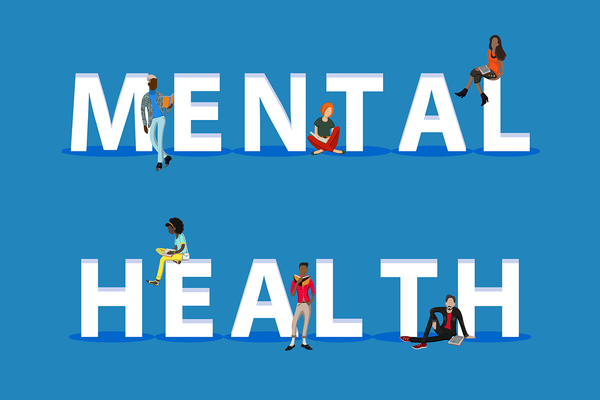Accessibility and Mental Health Conditions
Accessibility is the degree to which a product, service, or environment is available to as many people as possible. The concept of accessibility has historically focussed on people with physical or sensory disabilities and their right of access. HEIs have spent considerable amounts of money ensuring the physical access to buildings accommodates physical and sensory impairments as far as possible. In addition, assistive technology and software has promoted access (and fuller participation in society) for people with physical or sensory disabilities and arguably some hidden disabilities such as specific learning difficulties. Some examples include wheelchair ramps/turning spaces, lifts, new computer software programs, hearing loops, high contrasting colours, etc.
Little attention has, however, been paid to the range of psychological access issues encountered by people with mental health difficulties. Given that mental health difficulties are the leading cause of disability amongst young people, there is a strong argument for saying that efforts aimed at people with mental health conditions should feature prominently in making the environment and HEI organisational practices accessible generally.
The Equality Act (EA) means that Higher Education Institutions (HEIs) have a duty to make “reasonable adjustments” to take into account the needs and circumstances of disabled students . The EA requires reactive adjustments - responding to individual student’s needs – and anticipatory adjustments to be made.
Anticipatory adjustments are strongly related to the concept of universal design; making things accessible to all people whether they have a disability or not. Anticipatory adjustments aimed at students with mental health difficulties have been fairly few and far between across the sector.
As a greater number of people in HEIs come to understand that creating an inclusive learning and living environment is of central importance to the business of HEI’s, this will undoubtedly begin to change. Discussion of all the challenges between environment/organisational practices and mental health difficulties, and the effects on access to education, is beyond this paper. However, it may affect diverse areas such as recruitment and selection processes, open days, design and delivery of the curriculum, building design, assessments, social facilities, etc.
This paper specifically considers access to HEI mental health provision, which will clearly be of high importance to the commissioners of services that are expected to assess the access needs of students with mental health conditions for the HEI, as well as those services that provide continued support beyond the initial assessment.
Wellbeing and Rights
Students are expected to self-manage their studies and their mental health, resting on a self-selective approach to seeking support should difficulties arise. Due to the direct effects of the mental health conditions experienced (e.g. shame, stigma, lethargy, anxiety, paranoia) students may find it difficult to access those services. By actively considering the access issues barriers or resistance to making use of services may be minimised.
The stigma associated with mental health conditions means that only a fraction of students currently consider psychological access to services they make use of, instead formulating this as another personal challenge to overcome. For the HEI, it is important to reflect that the EA still applies in terms of making positive changes to improve access, irrespective of a particular student’s perception of this.
When considering access for students with mental health conditions, a comment that is sometimes made is that the access arrangements would benefit all students. This is sometimes given as a reason for inactivity, although the logic for such a conclusion is counter-productive. In fact, in some instances, what could be considered anticipatory adjustments for students with mental health conditions have been made precisely because they were felt to be generally useful.
Mental health conditions are one of the last taboos; in our society, however, there are very encouraging signs that this is beginning slowly to break down. As this happens, people with mental health conditions are likely to become far more vociferous in demanding their rights, and as such an HEI is likely to benefit from anticipating this, and cutting down on unnecessary stumbling blocks for students accessing mental health services. If current concerns of students relate to their access to a service itself, this should act as an indicator that consideration needs to be given to whether the current provision is as inclusive as it could be.
Furthermore, it is also important that the HEI acknowledges the access issues of those students who have mental health conditions, but who do not meet the legal definition, and are nevertheless disabled within the specific context of undertaking a course. E.g. A student who self-harms in reaction to stress during examinations may have never
spoken to a medical professional about their condition but such students may still benefit from accessing specific HEI-provided mental health support.
1 in 4 people experience a mental health difficulty at some point in their lives and the first onset of such difficulties is often amongst people between the ages on 18-30, then when people of this age develop such problems, they often have less effective coping strategies than older people might. It therefore means that any institution which is serious about student retention and progression cannot afford to ignore the issue of access to mental health support specific to the education context.
Specific Recommendations and Considerations
In order to promote psychological accessibility, especially to mental health-related services, commissioners and designers should consider the following:
Language, marketing and prominence of service
Stigma is commonly associated with any form of disability, and psychological access will need to incorporate an aspect of neutralising this. Mental health services need to be flexible in their marketing to respect the way students may see themselves, their capabilities and their group identities. Marketing mental health services in a way that makes them appear obvious for people identifying with the label of “mental health condition” is important, as is preserving the appeal for those who do not identify with this or a disability label.
Ensuring that the mental health service is located in an easy-to-find building will be important, as well as permitting some visibility of the service in order to challenge stigma (and ensure mental health “comes out of the closet”). This will need to be balanced by consideration of the need for privacy and dignity for people who may need to use the service.
Flexible availability of service for students
Ensuring flexible availability of assessment and/or support is particularly valuable, since students often approach services for support at critical times, when anxiety, low self-worth, paranoia may affect their use of those services.
The time of day at which a student is able to make use of support can vary. For example a student who has sleeping difficulties, or who takes medication, which makes them lethargic in the morning, may benefit from later appointments. Students with mental health conditions may feel overwhelmed or experience concentration problems. Varying the pace and duration of appointments is therefore useful. Other methods of ensuring assessment/support is provided (e.g. email, virtual meetings) may also promote flexible availability of, and access to, services.
It is therefore important to consider adequately resourcing specialist staff to ensure access to the service at times when students need it. It is also important that boundaries are maintained in the prioritisation and provision of appointments (whether of an assessment and/or supportive nature). This emphasises the benefits of a student’s access to the service being assessed by someone with specialist knowledge of mental health difficulties. UMHAN would argue that in most cases this should be a specialist Mental Health Advisor (MHA). Given the limited attention paid to access to services, the role of the MHA would necessarily be about making access recommendations regarding their own service. Further details are available in the UMHAN paper “Developing HEI mental health provision”
Physical space for students
Ensure rooms have natural light, or is suitably lit. The room should not be too small as close proximity may be difficult for some students. As anxiety leads to the body being flooded with chemicals such as adrenaline and nor-adrenaline sitting still for protracted periods of time can be very difficult for some students with mental health conditions, for this reason some students will need to be able to get up and move around. Sufficient space to allow the student to sit near a window or a door.
Equally chairs should be comfortable, and the room inviting, to help the student feel more at ease and able to talk about their experience Keep the room private, and create a space where the student cannot be observed or overheard by others and also out of sight from people who are not involved. Keep it away from the lift or the stair where many people will use often.
The room should be quiet, without any noise from outside. However, for some students, being allowed to play quiet background music can alleviate anxiety, so facility to play quiet music may be useful.
As anxiety difficulties can lead to people needing to use the toilet frequently, ensure appointment rooms are close to a toilet. Some students may also want to make use of the toilets to compose themselves before returning to lectures.
For some students, formality significantly raises anxiety levels. For this reason, trying to ensure an air of informality and personalisation in the building will be useful. Offering the student a cup of tea or glass of water can also help reduce anxiety levels and provide a welcoming environment, therefore the service would benefit from having access of the use of tea making facilities.
Use of space by students
Some students may benefit from being accompanied by someone they feel comfortable with; this may be a support worker, friend, or personal tutor. Some students may wish this person to accompany them throughout the meeting. Likewise, some meetings will necessarily involve other colleagues from within the HEI. Therefore, sufficient space and furniture needs to be available in such circumstances.
Some students will find it useful to bring items into meetings. These may include drinks; students who experience anxiety often find that they experience a dry mouth. Food can also be useful, if the student suffers from fluctuating energy levels, being able to maintain a consistent level of blood sugar may be important. Some students may also need to bring medication. On a more personal level, some students may have small items of property, which provide them with some level of comfort, which they may wish to bring in with them.
Students who experience some difficulties may require access to their HE intranet, so provision of facilities for student to access information will be useful. This will also be of relevance for the member of staff meeting them who will also require adequate infrastructure for them to adequately discharge their duties (e.g. suitable furniture, IT equipment, space for meetings and liaison; as well as time for liaison, networking, supervision, development, etc).
Room types for specialist services
Individual rooms are needed for assessments and ongoing mental health support owing to the confidential nature of the work, as well as logistical reasons such as students needing flexibility to adjust their time slots on a weekby-week basis. Providing dedicated room space makes for generally consistent appointment-keeping and easy access to the service for students and staff.
Additionally, MHAs require access to information resources, telephone, a computer, and a room that is not disrupted or overlooked, in order to meet students and liaise effectively with other services and provide advice without confidential information being seen/heard.
It is also beneficial to have a waiting area and resource area for students. This will enable students to arrive at the offices for support or initial meetings early, which is often crucial for people who are anxious or are going through a crisis in order to compose themselves as much as possible. This may also be true of students who wish to take some time after the session before returning to lectures. The waiting area also means that resources about mental and physical health (self-help, information about other services, groups, local facilities, etc.) are available for students to pick up while waiting.
Dan Doran (Mental Health Co-ordinator, Loughborough University).
With thanks to Liz Thackeray-Davies for her comments on the initial draft









